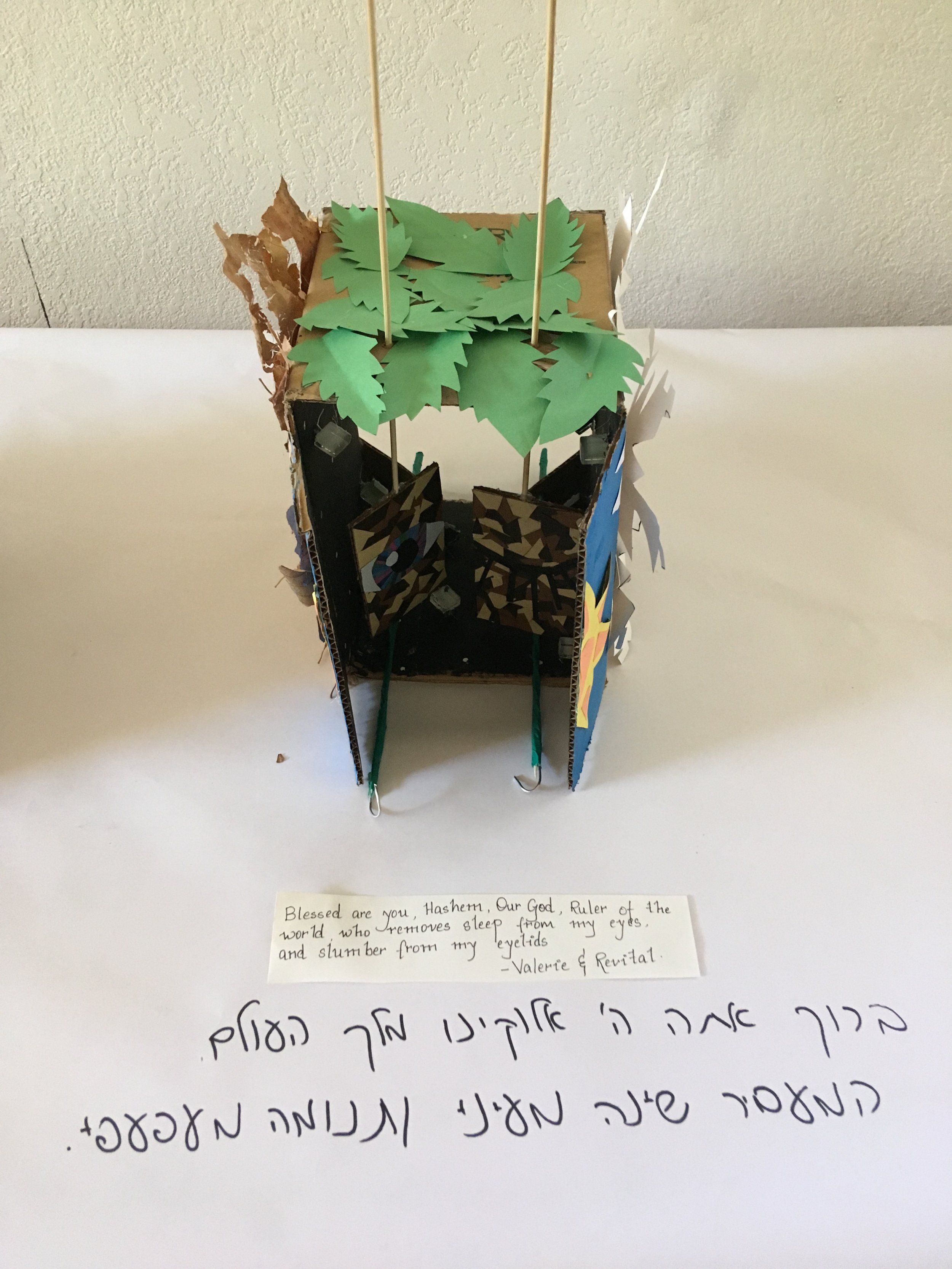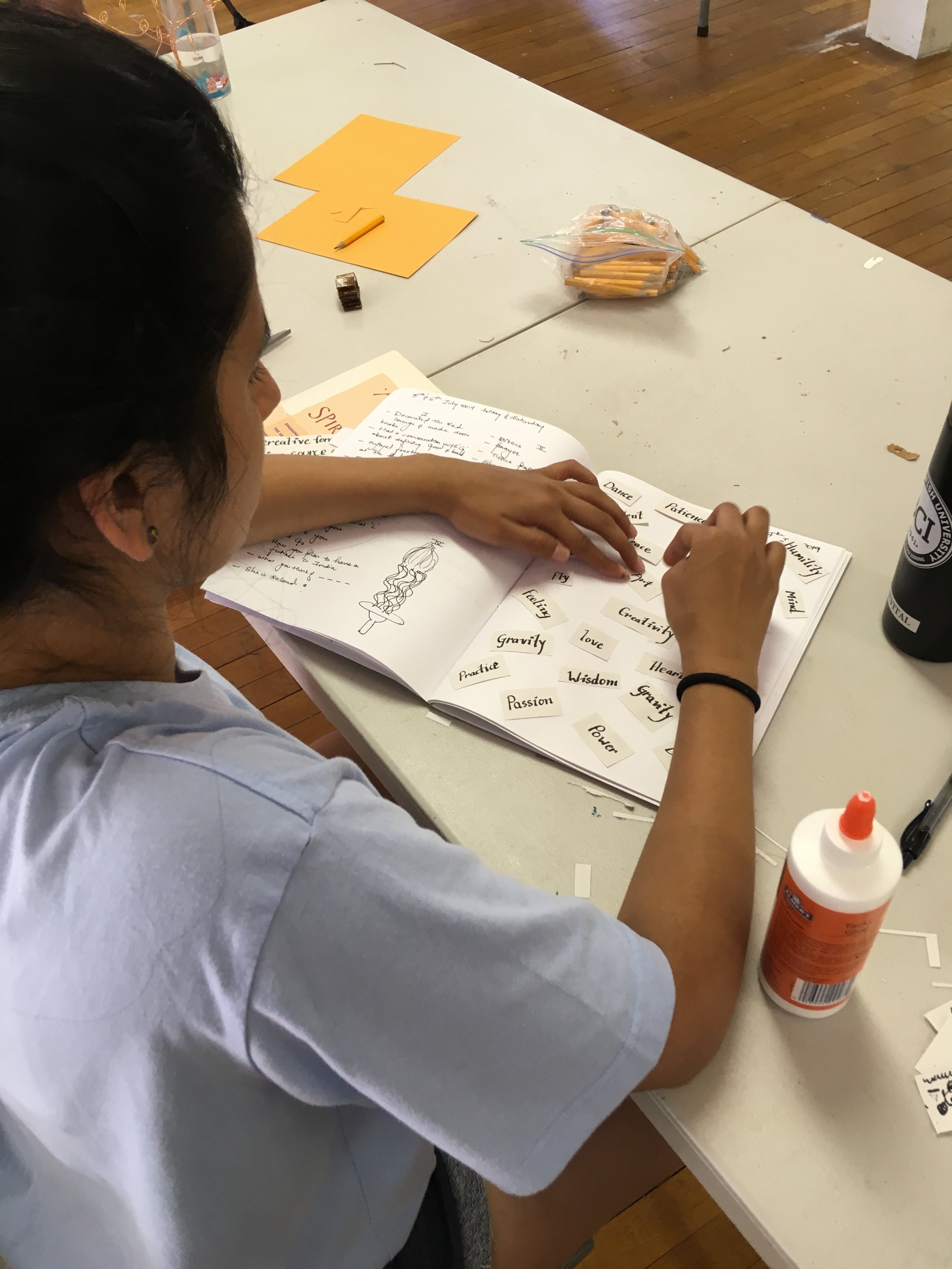The Brandeis Collegiate Institute (BCI) is an intensive learning and arts summer program outside of LA for young Jewish adults ages 20-29, from all around the world. There are five Jewish learning tracks that meet every the morning, and five arts workshops every the afternoon (participants join a consistent cohort for learning and arts, respectively, for the whole summer); Atiq went on the road to BCI this summer to facilitate one of the arts workshop tracks!
For our time at BCI, I had this dream that we could create a tactile, interactive experience of prayer by creating sacred objects aligned with and inspired by each of the key elements of traditional morning prayer (morning prayer, Shacharit, is in a certain sense an archetype for all other liturgical prayer). I was hoping we could weave together a focus on fixed/liturgical prayer and personal/spontaneous prayer.
Morning Blessings/ Birchot Hashachar - Liturgical
We began this sacred tinkering experiment with each pair/chevrutah of participants working on a different morning blessing. The morning blessings are one of the first primary elements of traditional Jewish prayer. In Kabbalistic thought they’re connected to the world of Asiya - the world of action, of particular attention to the body, the physical world. Morning blessings are an opportunity to express gratitude in that arena, as well as a sense of hope, aspiration and compassion. Each pair of participants worked with their assigned/chosen blessing through movement, drawing, and sound exercises and then brought those to bear in the creation of an automata (a simple machine that uses motion to convey a story or emotion) inspired by their blessing. It always feels pretty magical to experience how truly minimal, simple motion can be so evocative, and that was indeed the case with these Morning Blessing automata (automatas?).
Morning Blessings/ Birchot Hashachar - Personal
Part B of our Morning Blessings section involved creating personal morning blessings and objects. We’d been using Lynda Barry’s journaling method, which I love, where you simply gather data about your day (7-10 things I did today, 7-10 things I saw today, a drawing of something I saw, a snippet of something I heard someone say...) so we surveyed what the first 2-3 items were in our “what I did today” lists, and tried to create something that honored or elevated, brought more thoughtfulness or gratitude to one of our typical modes for beginning the day. The form of the blessing and of the interactive object was completely open - no specific parameters. We ended up with a special box to put a natural treasure in - a mini sanctuary; a series of different trees towards the prayer “grow where you’re planted”; a meditation sign on the gift of music; a food basket for the car to hold snacks for homeless people; a tiara for centering appreciation of animate and less-obviously-animate worlds.
Verses of Song or Pruning / Psukei D’Zimra
The second major element of morning prayer is the Psukei D’Zimra, which translates to either verses of song or verses of pruning (like pruning a plant or a tree). This section of Shacharit is kabbalistically associated with the world of Yeztirah, which is rooted in emotion. It is an encounter with many psalms and other verses of praise for the Divine, aimed at either elevating our appreciation of Divinity as expressed in this world, or at clearing our hearts (pruning), to allow for greater attunement to the Godly presence.
Our work for this section focused on the pillars of Psukei D’Zimra - Baruch She’Amar, Ashrei, and Yishtabach. We reflected on arenas of experience that have connected each of us to a sense of Divinity, awe, wonder. We brought these into the physical realm through methods of embellishing and cutting away - papercutting, block print making, pop ups, and other forms of paper engineering - all designed to heighten a sense of glory, royalty, awe.
Shema and Associated Blessings
Shema and associated blessings before and after is the third major element of morning prayer. Kabbalistically this section is connected to the world of Beriah - intellectual, cerebral understanding. The first verse - Shema Yisrael, Adonai Eloheinu Adonai Echad - Hear O Israel, the Lord our God, the Lord is One - is one of the most widely known verses of Jewish prayer and belief. It has associations of being both a very personal intimate prayer, and also a prayer of communal connection and belonging. To reflect that, we did a variety of exercises to arrive at our own personal and communal pathways within Shema - we cycled through declaiming the Shema to individual people in our group, using their own name in place of the more general/communal “Yisrael” (ie, Shema, Adina, Adonai Eloheinu Adonai Eched) - this exercise was imagined by Reb Zalman Schachter Shalomi, of blessed memory, and was suggested to me by Yoel Sykes - may he live and be well!; we also share our own memories and associations with hearing, learning, and saying the Shema. We then used a “Yes, And” approach, borrowed from the improv comedy/improv theater world, to collaboratively answer the question: What are we making that helps us and others inhabit the space and sensability of the Shema? Then, we set our intention: We trusted each other to put these items on this list, without editing or erasing, and now we can trust each other to create the physical expression of this list, in whatever way that needs to manifest. We worked alone and together, but always with the surrounding intention of collaborative yes and-ing with no need to shut any ideas down, but instead to work from an assumption that we were all on the inside, on the level.
Silent Standing Prayer / Amidah
The fourth primary element of morning prayer is the Amidah - Standing Prayer also called Shmoneh Esrei (the prayer of 18, or in reality, 19, blessings). The Amidah can be considered the pinnacle of prayer, and is Kabbalistically associated with the world of Atzilut - complete intuitive connection and presence with the Divine. We brought this sensibility and intention to the process of designing and building our interactive, immersive experience, and also included it as a distinct element at the end of the experience. As visitors/pray-ers arrived at the threshold to emerge from the Living Prayer experience, they arrived at the Amidah section, which included a gateway of precisely braided threads, representing the 19 blessings of the Shmoneh Esrai, and as they emerged into the fresh air and sunshine, were encouraged to pause for a moment of standing silent prayer before reconnecting with the world around them.
Chagigah - Arts Celebration
Our Living Prayer experience touched off Chagigah at BCI, a powerful opportunity to experience the culmination of work from each of the five arts workshops. We were so delighted to be able to invite all the BCI participants and staff into this opportunity for sacred attunement, as the entry way to all of the creative offerings that evening. So honored to get to share our work with you now in this space!
You still here? Can I tell you the best part? Remember I said at the way beginning that I had a dream of creating a tactile, interactive experience of the arc of morning prayer? I didn’t exactly convey the fullness of this dream to workshop participants - it felt like it would be too overwhelming to try to lay out some grand plan. So after giving just a taste of prayerful progressions by playing the Arba Bavos, a lengthy and revered four part Chabad melody, and following that with Bohemian Rhapsody, by Queen (ok, I recognize that considering these both forms of prayer is a bit whacky), we set off into the tinkering and making for each section of morning prayer.
By the time we got to the work of putting it all together to share our work for Chagigah, I watched and listened in amazement as my students began creating their own version of my dream. With minimal facilitation from me, they engaged in a continuous process of making space for each other’s ideas - including, by the end, spray painted walls that mapped our theme for summer - Talmudic sage Hillel’s three part teaching of “If I am not for myself, who will be for me?; If I am only for myself, what am I?; If not now, when?” - on to the progression of morning prayer. In doing so they brought to life an immersive instillation that was better than a dream (real life basically always is), and was a version of the best kind of communal prayer - space for individual expression, creativity, connection, but with the energy that results from shared journey towards relationship with the Divine.
Love and endless gratitude to the participants of the BCI/Atiq Tinkering Workshop: Valerie Brown, Kanaan Goldstein, Eliana Schnulner, Emily Resnik, Olya Malov, Revital Moses, Pam Green, Oliver Pemberton, Shirel Buechler, and Alexa Vecchio; and of course, to the Source of creativity and prayer.

































































































